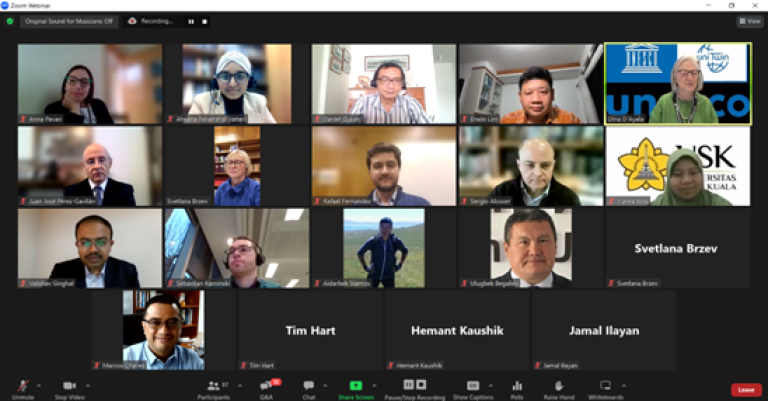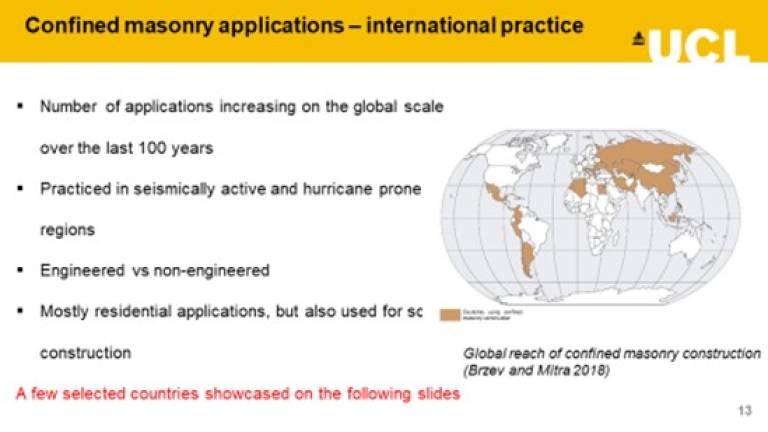Global symposium on recent advancements and the way forward in confined masonry construction
8 March 2024
The UNESCO Chair with the support of Earthquake Engineering Research Institute (EERI), ARUP and Build Change has recently organised a 2-day online symposium on the topic of Confined Masonry (CM) construction practice: recent advances and the way forward, from 8 to 9 February 2024
The UNESCO Chair with the support of Earthquake Engineering Research Institute (EERI), ARUP and Build Change has recently organised a 2-day online symposium on the topic of Confined Masonry (CM) construction practice: recent advances and the way forward, on 08 and 09 February 2024. The webinar was co-chaired by Prof Svetlana Brzev, Chair of the EERI CM network. This event was a unique opportunity to bring together experts and practitioners from around the globe to examine the current status, in terms of field applications and variations in construction practices, research and design codes, and to identify potential gaps to be addressed by future research studies and implemented in practice. Twenty invited speakers, based in fifteen countries, debated three different themes:
- Current status and gaps of design codes and research
- Application of confined masonry for schools
- Seismic retrofitting and adaptation for durability and climate change
The first theme spotlighted the current status and scope of design codes for confined masonry in countries around the world, identifying the areas for further development. Acknowledging the primary target of facilitating educational resilience from natural disasters, the second theme delved into school construction using confined masonry technique, sharing experiences and challenges from several countries: Mexico, Peru, Indonesia, Kyrgyzstan, Philippines and Iran. The second focused retrofitting strategies for existing confined masonry buildings, their standardisation and the urgent need for incorporating durability and climate resilience into their design and construction. Panel discussions and interactive Q&A sessions turned into lively discussions, generating critical guidance for future research and innovation.

*Screenshot from Day 1 of the symposium
The event was well received by a global audience of more than 320 participants from 52 countries, with more than 20 registrations from Indonesia, Colombia, India, UK, Peru and USA, and over 150 participants tuned in at any given time. For interested parties, the recording of the symposium is made available at: https://www.ucl.ac.uk/epicentre/unesco-chair/unesco-chair-educational-ac...
where you can also find all other educational activity of the UNESCO Chair in DRR-RE
The global interest this event received is proof of the increasing demand for catering to sustainable and disaster resilient construction techniques such as Confined Masonry which are also economically viable. To this end the UNESCO Chair is organising a number of follow up activities:
- A repository of the symposium presentations, codes and guidelines relevant to confined masonry construction practice, initiated by Dr. Svetlana Brzev, is available at: https://www.dropbox.com/scl/fo/de3lahc3sp5o67syh0tzk/h?rlkey=k1idbcadzqp...
- A whitepaper is being drawn up on the basis of the presentations and discussions with the participation of all speakers. The whitepaper will be published on the EERI website and presented at the World Conference in Earthquake Engineering in Milan in July 2024 (WCEE24).
- You can hear more about it during the special session RES-3 of the WCEE24, where organised by Svetlana Brzev and Tim Hart https://www.wcee2024.it/contributions/.

 Close
Close

